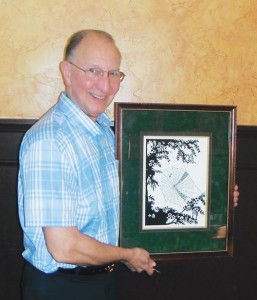
By Tanner Russ
Silverton artist Jim Bornzin can do some pretty amazing things with scissors.
Well, not just any scissors. He uses fine-pointed, surgical scissors for his art.
“Scissor art is a German art form called scherenschnitte based on silhouette cutting which began in France many centuries ago. It’s also done in the Orient and nowadays it’s done with lasers but I continue to use fine-pointed, surgical scissors for my cutting,” Bornzin said.
Bornzin’s work will be on display at the White Oaks Gallery, 216 E. Main St., Silverton beginning Friday, Nov. 6.
Bornzin’s love and appreciation of art was shared by his family. It was encouraged early on.
“When I was in high school, I really enjoyed art work so I worked for my uncle who was a commercial artist in Chicago, and he had a beautiful studio on the 17th floor on Michigan Avenue overlooking Grant Park and Lake Michigan,” Bornzin said. “I worked there three summers and really learned a lot about commercial art and watercolors illustration.”
Bornzin created a few pieces in his free time, one in high school, one in college, and two while he was in the seminary.
Another influence on Bornzin’s art was its connection to his faith.
The now-retired Lutheran pastor served internships in both Sacramento and Spokane. It was his time in Washington that helped shape his artistic choices, scenes of the wilderness and natural landscapes.
Bornzin said finding time for his art while serving as pastor was difficult.
“I was ordained in 1966 and served as a Lutheran pastor for 40 years,” Bornzin said. “That included some volunteer work with community agencies. I worked as a volunteer chaplain at Silverton Hospital and I worked as a police chaplain when I was in Coos Bay. I enjoyed ministry very much, but art became a past time I only had occasional hours for. So once or twice a year, I would pick up paper and do a scissor cut.”
After retiring and relocating to Silverton, Bornzin found his stride and has been steadily creating new works.
The work is all connected, cut from one sheet of paper. The whole process can take several days to complete.
“I don’t usually keep track, but I know on the smaller ones it will be a day or two of four to six hours of cutting,” Bornzin said. “I’ll cut for two to three hours at a time, then I’ll take a break, eat lunch, eat dinner, then come back to it in the evening. Big ones can take a week or two. Maybe 40 or 50 hours, I don’t keep track.
“As long as the good Lord gives me the eyesight to do it, I’ll keep doing it,” Bornzin said with a chuckle.
For information on Jim Bornzin, visit his website at jimbornzin.com.